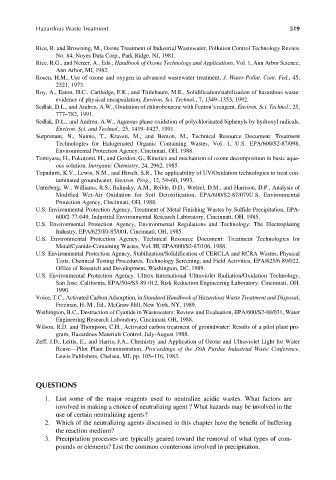Page 548 - Materials Chemistry, Second Edition
P. 548
CAT3525_C16.qxd 1/27/2005 12:42 PM Page 519
Hazardous Waste Treatment 519
Rice, R. and Browning, M., Ozone Treatment of Industrial Wastewater, Pollution Control Technology Review
No. 84, Noyes Data Corp., Park Ridge, NJ, 1981.
Rice, R.G., and Netzer, A., Eds., Handbook of Ozone Technology and Applications, Vol. 1, Ann Arbor Science,
Ann Arbor, MI, 1982.
Rosen, H.M., Use of ozone and oxygen in advanced wastewater treatment, J. Water Pollut. Cont. Fed., 45,
2521, 1973.
Roy, A., Eaton, H.C., Cartledge, F.K., and Tittlebaum, M.E., Solidification/stabilization of hazardous waste:
evidence of physical encapsulation, Environ. Sci. Technol., 7, 1349–1353, 1992.
Sedlak, D.L., and Andren, A.W., Oxidation of chlorobenzene with Fenton’s reagent, Environ. Sci. Technol., 25,
777–782, 1991.
Sedlak, D.L., and Andren, A.W., Aqueous phase oxidation of polychlorinated biphenyls by hydroxyl radicals,
Environ. Sci. and Technol., 25, 1419–1427, 1991.
Surprenant, N., Nunno, T., Kravett, M., and Benton, M., Technical Resource Document: Treatment
Technologies for Halogenated Organic Containing Wastes, Vol. 1, U.S. EPA/600/S2-87/098,
Environmental Protection Agency, Cincinnati, OH, 1988.
Tomiyasu, H., Fukutomi, H., and Gordon, G., Kinetics and mechanism of ozone decomposition in basic aque-
ous solution, Inorganic Chemistry, 24, 2962, 1985.
Topudurti, K.V., Lewis, N.M., and Hirsch, S.R., The applicability of UV/Oxidation technologies to treat con-
taminated groundwater, Environ. Prog., 12, 54–60, 1993.
Unterberg, W., Williams, R.S., Balinsky, A.M., Reible, D.D., Wetzel, D.M., and Harrison, D.P., Analysis of
Modified Wet-Air Oxidation for Soil Detoxification, EPA/600/S2-87/079U.S, Environmental
Protection Agency, Cincinnati, OH, 1988.
U.S. Environmental Protection Agency, Treatment of Metal Finishing Wastes by Sulfide Precipitation, EPA-
600/2-77-049, Industrial Environmental Research Laboratory, Cincinnati, OH, 1985.
U.S. Environmental Protection Agency, Environmental Regulations and Technology: The Electroplating
Industry, EPA/625/10-85/001, Cincinnati, OH, 1985.
U.S. Environmental Protection Agency, Technical Resource Document: Treatment Technologies for
Metal/Cyanide-Containing Wastes, Vol. III, EPA/600/S2-87/106, 1988.
U.S. Environmental Protection Agency, Stabilization/Solidification of CERCLA and RCRA Wastes, Physical
Tests, Chemical Testing Procedures, Technology Screening, and Field Activities, EPA/625/6-89/022,
Office of Research and Development, Washington, DC, 1989.
U.S. Environmental Protection Agency. Ultrox International Ultraviolet Radiation/Oxidation Technology,
San Jose, California, EPA/504/S5-89-012, Risk Reduction Engineering Laboratory, Cincinnati, OH.
1990.
Voice, T.C., Activated Carbon Adsorption, in Standard Handbook of Hazardous Waste Treatment and Disposal,
Freeman, H. M., Ed., McGraw-Hill, New York, NY, 1989.
Wethington, B.C., Destruction of Cyanide in Wastewaters: Review and Evaluation, EPA/600/S2-88/031, Water
Engineering Research Laboratory, Cincinnati, OH, 1988.
Wilson, R.D. and Thompson, C.H., Activated carbon treatment of groundwater: Results of a pilot plant pro-
gram, Hazardous Materials Control, July-August 1988.
Zeff, J.D., Leitis, E., and Harris, J.A., Chemistry and Application of Ozone and Ultraviolet Light for Water
Reuse—Pilot Plant Demonstration, Proceedings of the 38th Purdue Industrial Waste Conference,
Lewis Publishers, Chelsea, MI, pp. 105–116, 1983.
QUESTIONS
1. List some of the major reagents used to neutralize acidic wastes. What factors are
involved in making a choice of neutralizing agent ? What hazards may be involved in the
use of certain neutralizing agents?
2. Which of the neutralizing agents discussed in this chapter have the benefit of buffering
the reaction medium?
3. Precipitation processes are typically geared toward the removal of what types of com-
pounds or elements? List the common counterions involved in precipitation.

